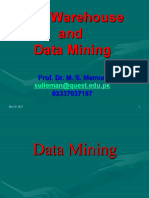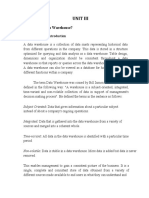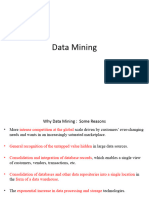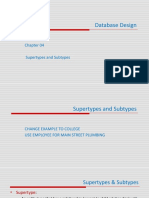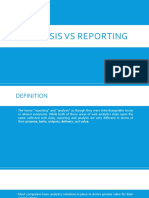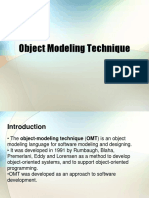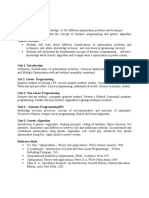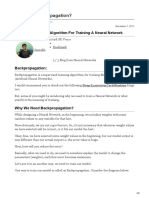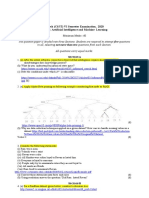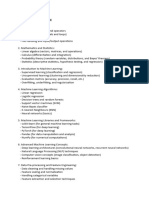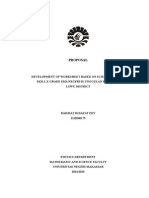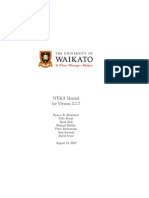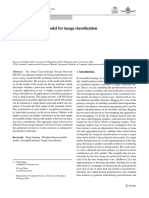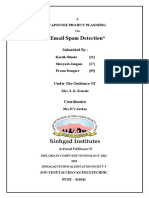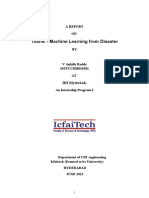Course Title: Data Warehousing and Data Mining
Course no: CSC-451
Full Marks: 60+20+20
Credit hours: 3
Pass Marks: 24+8+8
Nature of course: Theory (3 Hrs.) + Lab (3 Hrs.)
Course Synopsis: Analysis of advanced aspect of data warehousing and data mining.
Goals: This course introduces advanced aspects of data warehousing and data mining,
encompassing the principles, research results and commercial application of the current
technologies
Unit
Lecture
Course content-breakdown
Introduction
What motivated Data mining? What is Data Mining?
Types of databases (Relational database, Data
Hours
5
Warehouses, Transactional Database)
Functionalities of data mining What kinds of Pattern
can be mined?
Association Analysis, Cluster Analysis, Outlier
Analysis, Evolution Analysis
Stages of Knowledge discovery in database(KDD)
Setting up a KDD environment
Issues in Data Warehouse and Data Mining
Application of Data Warehouse and Data Mining
Data Warehouse for Data mining
Differences between operational database systems and
data warehouses
Data Warehouse Architecture
Distributed and Virtual Data Warehouse
Data Warehouse Manager
Data marts, Metadata, Multidimensional data model
From Tables and Spread Sheets to Data Cubes
Remarks
Star schema, Snowflake schema and Fact constellation
schema
OLAP technology for Data Mining
On-line analytical processing models and operations
(drill down, drill up, slice, dice, pivot)
Types of OLAP Servers: ROLAP versus MOLAP
versus HOLAP
OLTP
Tuning for data warehouse
Computation of Data Cubes, modeling
OLAP data, OLAP queries
Data Warehouse back end tools
Tuning and testing of Data Warehouse
Data Mining techniques
Data Mining definition and Task
KDD versus Data Mining
Data Mining techniques, tools and application
Data mining query languages
Data mining query languages
Data specification, specifying knowledge, hierarchy
specification, pattern presentation & visualization
specification
Data mining languages and standardization of data
mining
Association analysis
Association Rule Mining (Market basket analysis)
Why Association Mining is necessary?
Pros and Cons of Association Rules
Apriori Algorithm
Cluster analysis, Classification and Predication
What is classification? What is predication?
Issues regarding classification and prediction (Preparing
the data for classification and prediction, Comparing
classification methods)
Classification by decision tree induction (Extracting
classification rules from decision trees)
Bayesian Classification
Classification by back propagation
Introduction to Regression (Types of Regression)
Clustering Algorithm (K-mean and K-Mediod
Algorithms)
Advanced concepts in data mining
Mining Text Databases
Mining the World Wide Web
Mining Multimedia and Spatial Databases
Laboratory:
1. Creating a simple data warehouse
2. Concepts of data cleaning and preparing for operation
3. Implementing classification and clustering algorithms in any programming language
4. Association rule mining though data mining tools
5. Data Classification through data mining tools
6. Clustering through data mining tools
7. Data visualization through data mining tools
�Text Books:
1. Data Mining Concepts and Techniques, Morgan Kaufmann J. Han, M Kamber Second Edition
ISBN: 978-1-55860-901-3
2. Data Warehousing in the Real World Sam Anahory and Dennis Murray, Pearson Edition
Asia.
References:
1. Data Mining Techniques Arun K Pujari, University Press.
2. Data Mining- Pieter Adriaans, Dolf Zantinge
3. Data Mining, Alex Berson,Stephen Smith,Korth Theorling,TMH.
4. Data Mining, Adriaans, Addison-Wesley Longman.
�Model Question
Full marks:
60
Pass marks: 24
Time: 3 hours.
Bachelor Level/ Fourth Year/Eight Semester/Science
Data Warehousing and Data Mining (CSC-451)
Candidates are required to give their answers in their own words as far as practicable. The
figures in the margin indicate full marks.
Group-A
Long Answer Questions (Attempt any Two questions)
[2x10=20]
1. Suppose that a data warehouse for Big University consists of the following four
dimensions: student, course, semester, and instructor, and two measures count and avggrade. When at the lowest conceptual level (e.g., for a given student, course, semester, and
instructor combination), the avg-grade measure stores the actual course grade of the
student. At higher conceptual levels, avg-grade stores the average grade for the given
combination.
a) Draw a snowflake schema diagram for the data warehouse.
b) Starting with the base cuboid [student, course, semester, instructor], what specific
OLAP operations (e.g., roll-up from semester to year) should one perform in order to
list the average grade of CS courses for each Big University Student.
c) If each dimension has five levels (including all), such as student < major < status <
university < all, how many cuboids will this cube contain (including the base and apex
cuboids)?
2. A= {A1, A2, A3, A4, A5, A6}, Assume = 35%. Use A priori algorithm to get the desired
solution.
A1
0
0
1
1
1
0
0
A2
0
1
0
1
0
1
0
A3
0
1
0
0
1
1
0
A4
1
1
1
1
0
1
1
A5
1
0
1
0
1
0
1
A6
1
0
1
0
1
1
0
�0
1
1
1
0
1
0
0
1
1
1
1
0
0
1
1
0
1
3. What kind of data preprocessing do we need before applying data mining algorithm to any
data set. Explain binning method to handle noisy data with example.
Group- B
Short Answer Questions (Attempt any Eight questions)
Question number 13 is compulsory.
[8x5=40]
4. Explain the use of frequent item set generation process.
[5]
5. Differentiate between data marts and data cubes.
[5]
6. Explain OLAP operations with example?
[5]
7. List the drawbacks of ID3 algorithm with over-fitting and its remedy techniques
[5]
8. Write the algorithm for K-means clustering. Compare it with k-nearest neighbor
algorithm.
[5]
9. What is text mining? Explain the text indexing techniques.
[5]
10. Describe genetic algorithm using as problem solving technique in data mining.
[5]
11. What do you mean by WWW mining? Explain WWW mining techniques.
[5]
12. What is DMQL? How do you define Star Schema using DMQL?
[5]
13. Write short notes (Any Two)
a)
b)
c)
d)
[2x2.5=5]
Text Database Mining
Back propagation Algorithm
Regression
HOLAP
*****













